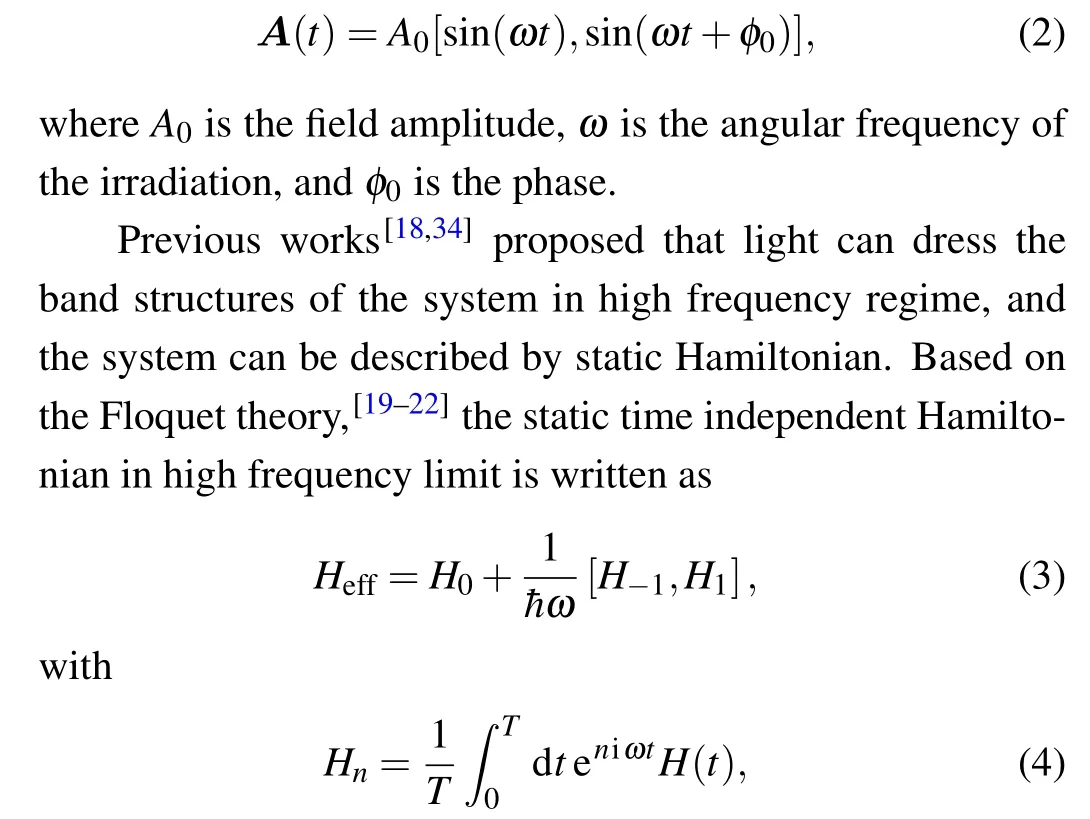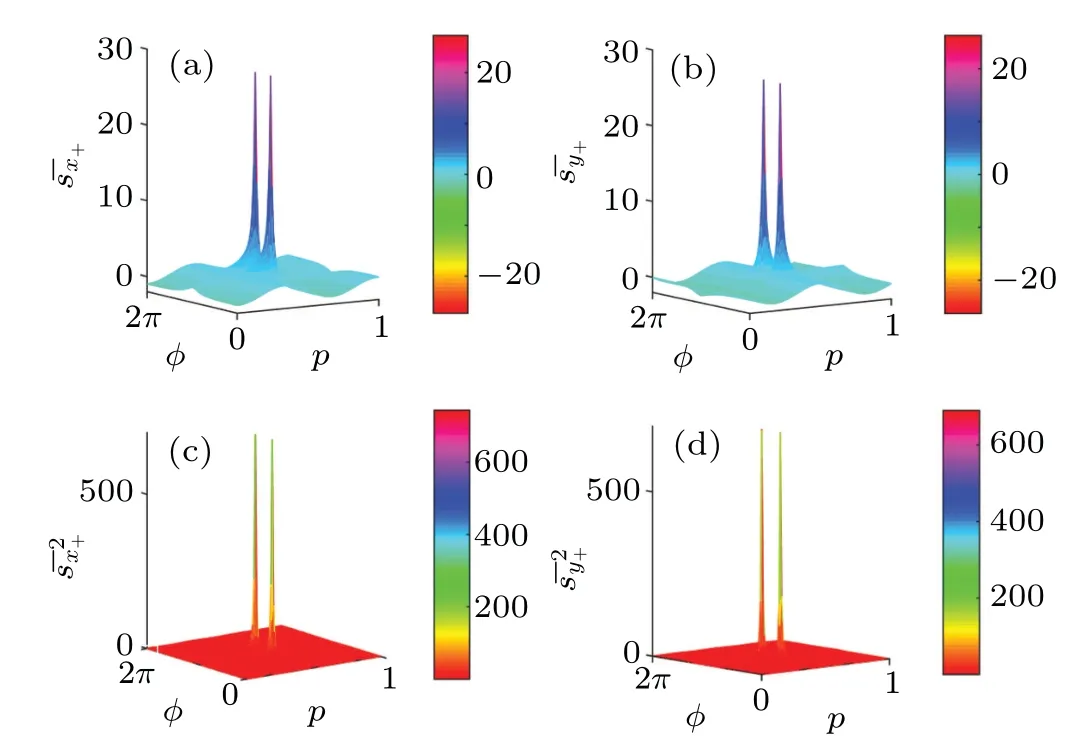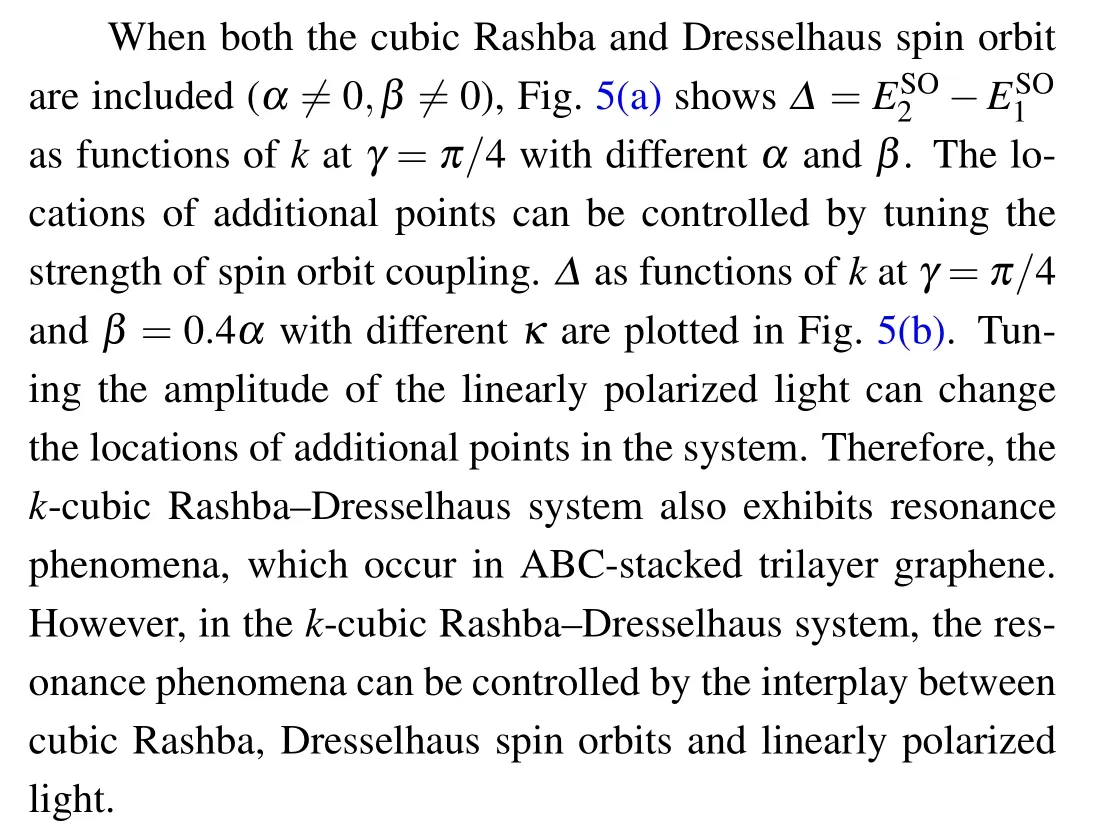Longitudinal conductivity in ABC-stacked trilayer graphene under irradiating of linearly polarized light
Guo-Bao Zhu(朱国宝) Hui-Min Yang(杨慧敏) and Jie Yang(杨杰)
1School of Physics and Electronic Engineering,Heze University,Heze 274015,China
2Shandong Graphenjoy Advanced Material Co. LTD,Dezhou 253072,China
Keywords: graphene,light,Floquet
1. Introduction
In recent years, trilayer graphene (TLG) has attracted a great deal of attention in condensed matter physics experimentally and theoretically due to the rise of graphene. In TLG,the stacking of three layers can be either ABA (Bernal-type)[1–4]and ABC (rhombohedral-type).[5–8]They have distinct electronic properties that are of interest both for fundamental science and for technological applications. The conduction and valence bands of ABC-stacked TLG have a approximately cubic dispersion and touch at the charge neutrality point.[6]Engineering of the band structure and understanding the corresponding transport properties of ABC-stacked TLG are critical to realize their applications. ABC-stacked TLG’s chiral band structure results in three Landau level orbits with zero kinetic energy.[9]An electric field perpendicular to TLG has been shown to open a band gap in TLG.[10,11]In ABC-stacked TLG aligned with boron nitride,the electronic structure of flat bands can be induced by moir´e sublattice and electric field.[12]The distinctive band structures can give rise to different transport properties. By using high-magnetic fields, Kumaret al.[13]have observed compelling evidence of the integer quantum Hall effect in TLG. In the presence of a perpendicular magnetic field,the ground state of ABC-stacked trilayer graphene is a uniform quantum Hall state where the electrons occupy the lowest unoccupied Landau level orbital index.[14]By tuning the interplay between the electric field and intrinsic spin coupling,a quantum spin Hall state or a quantum valley Hall state can occur in ABC-stacked TLG.[15]When ABC-stacked TLG is aligned with a hexagonal boron nitride substrate,quantum-Hall-like physics can be simulated by tuning a perpendicular electric field.[16]Chenet al.[17]have confirmed that the ABCstacked TLG exhibits a large anomalous Hall signal at zero magnetic field in experiment. However, in previous research of transports properties in ABC-stacked TLG,the longitudinal conductivity has rarely been taken into account.
On the other hand, Floquet engineering[18–22]has emerged as a powerful method for the realization of novel quantum systems with exotic properties. A graphene lattice system subjected to circular driving has been studied theoretically in a variety of frameworks. A circularly polarized light can open a gap in the Dirac cone, which is predicted to lead to a dc Hall current[23]in graphene in the absence of a uniform magnetic field, and has been reported in experiment.[23]Lifshitz transitions,[24]a Floquet isolator,[25]and valley polarization[26]have been investigated in bilayer graphene using circularly polarized light. In twisted bilayer graphene,the circularly polarized light can be used to control the modulation of interlayer hopping.[27,28]An off-resonant circularly polarized light drives chirally stacked TLG into a Floquet Chern insulator.[8]Band flattening effects and band gap openings have been found in twisted TLG due to the presence of the circularly polarized light.[29]However,the linearly polarized light has rarely been taken into account in previous considerations of irradiating of light.
The study of longitudinal conductivity is one of most interesting field in transport in Dirac materials. It can lead to understanding of the mechanisms that contribute to the anomalous Hall effect.[30,31]When graphene illuminated with circularly polarized light, longitudinal conductivity can be a realistic observable to detect light-induced Floquet band gaps.[32]Optical longitudinal conductivity can also be used to probe the topological phase transition.[33]Therefore,graphene is an important platform to find topological states for both scientific explorations and potential technological applications.
Given these background, we have studied the effects of linearly polarized light on ABC-stacked TLG.We have investigated the changes of band structure,layer pseudospin polarization, and longitudinal conductivity in ABC-stacked TLG when the light is present.
This paper is organized as follows. We firstly present the model Hamiltonian of TLG including the linearly polarized light,and analyze band structures in Section 2. Based on these results, we further obtain the evolution of layer pseudospin polarization in Section 3. The longitudinal conductivity is discussed in Section 4. In Section 5, we discuss the resonance phenomena ink-cubic Rashba–Dresselhaus system under the irradiating of linearly polarized light. Finally,we give a brief conclusion in Section 6.
2. Model Hamiltonian and energy spectrum
We begin the effective Hamiltonian of ABC-stacked TLG as follows:[5–8]

When the system is subjected to an external timedependent periodic perturbation in the form of light,the timedependent vector potential is expressed as

whereT=2π/ωis the time period of the light. The HamiltonianH(t)is obtained by including the light induced vector potential into Hamiltonian(1)byp →p+eA(t)/¯h,wheree<0 is the electron charge. For linearly polarized light(φ0=0),we obtainH(t)in ABC-stacked TLG as


Fig.1. Energy dispersions as functions of p in units of g3 for(a)κ =0 and (b) κ =0.2 at φ =π/2. The solid red and dotted blue curves are corresponding to E+ and E−respectively.
3. Layer pseudospin polarization


Fig. 2.sx+ (a),sy+ (b),sx2+ (c), and sy2+ (d) in the (p,φ/π) plane at κ =0.1.

Fig. 3. Layer pseudospin polarization sx+ [(a), (c)] and sy+ [(b), (d)] as function of φ at different κ for p=0.2 [(a), (b)] and p=0.6 [(c), (d)], respectively. The red dashed,black dotted,and blue solid curves correspond to κ =0,κ =0.1,and κ =0.2 for η =1,respectively.
4. Longitudinal conductivity
In this section, we investigate the longitudinal conductivity of ABC-stacked TLG under the irradiating of linearly polarized light. Based on Green’s function theory,[35–38]the longitudinal conductivityσiican be expressed as

is the retarded(advanced)Green’s function in the clean limit.In this paper, we consider the intrinsic contribution when the relaxation rate vanishes. Plugging Eq. (15) into Eq. (14), we can obtain





Fig. 4. Characteristics of σxx (in units of σ0 =e2/¯h) as a function of Ef. The red dotted, blue solid, and black dashed curves correspond to κ =0,κ =0.1,and κ =0.2,respectively.
5. Resonance phenomena in the k-cubic Rashba–Dresselhaus system under irradiating of linearly polarized light
Electronic structures of ABC-stacked trilayer graphene exhibit ak-cubic dispersion relation,and show resonance phenomena when the linearly polarized light is present. Another interesting way to include thek-cubic term is considering spin orbit coupling. In this section, we consider thek-cubic Rashba–Dresselhaus system under the irradiating of linearly polarized light. For thek-cubic Rashba–Dresselhaus system,the Hamiltonian[40,41]is given by



Fig.5. (a)∆=?−?as functionsof katγ=π/4 with different α andβ. (b)∆asfunctionsof k at γ=π/4andβ=0.4α with different κ.

6. Conclusions
We have shown that the linearly polarized light can induce the change of the band structure and longitudinal conductivity in ABC-stacked trilayer graphene. Most remarkably,the band structure of ABC-stacked trilayer graphene exhibits a pair of additional points, where conduct and valence bands touch.The points are responsible for the resonance phenomena of the longitudinal conductivity. The amplitude of linearly polarized light can be used to tune the locations of the additional points. Furthermore,the layer pseudospin polarization is sensitive to the light. At the larger Fermi energy,the longitudinal conductivity is unchanged for varyingEf, and the amplitude ofσxxcan be controlled by changingκ. We present the results of resonance phenomena in thek-cubic Rashba–Dresselhaus system under irradiating of linearly polarized light. Our results provide a way to control transport properties of Dirac materials.

Then the Floquet hamiltonian of topological insulator with hexagonal warping is

Acknowledgement
Project supported by the Shandong Provincial Natural Science Foundation(Grant No.ZR2021MA093).
- Chinese Physics B的其它文章
- Magnetic properties of oxides and silicon single crystals
- Non-universal Fermi polaron in quasi two-dimensional quantum gases
- Purification in entanglement distribution with deep quantum neural network
- New insight into the mechanism of DNA polymerase I revealed by single-molecule FRET studies of Klenow fragment
- A 4×4 metal-semiconductor-metal rectangular deep-ultraviolet detector array of Ga2O3 photoconductor with high photo response
- Wake-up effect in Hf0.4Zr0.6O2 ferroelectric thin-film capacitors under a cycling electric field

